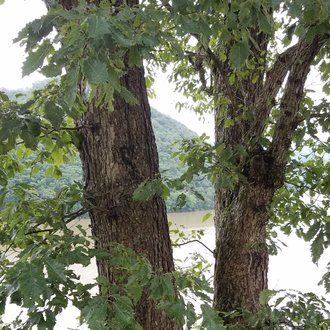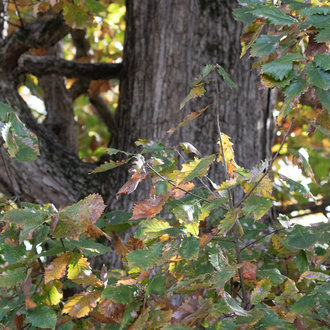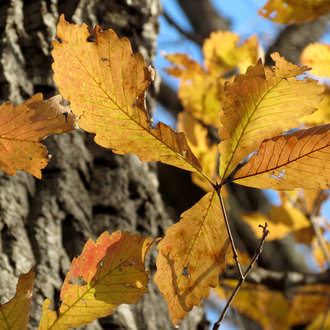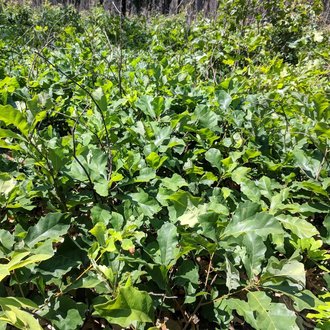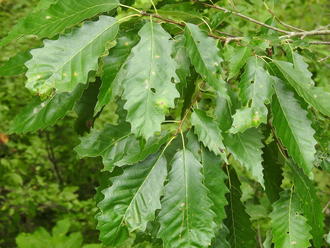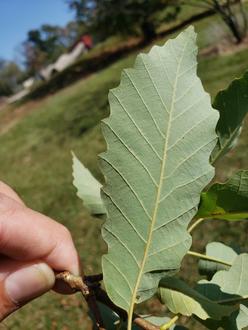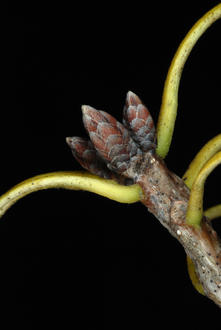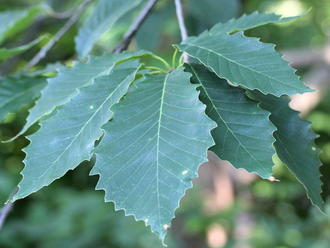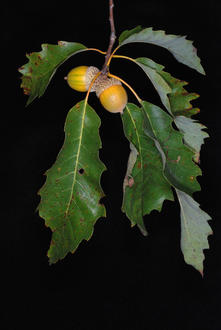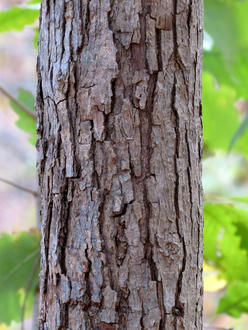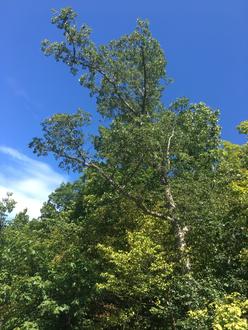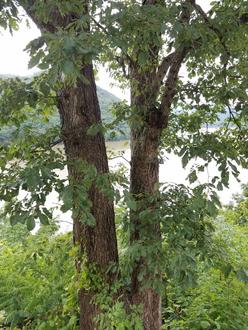Chinquapin Oak (Quercus muehlenbergii Engelm.)
Also known as chinkapin oak; also classified as Quercus muhlenbergii.
↑Summary
A white oak native to North America, preferring soils high in calcium.
↑Range - Expand
| Legend | Color |
| Native | |
| Native or Not Present |
This tentative map is based on our own research. It may have limited data on Canada and/or Mexico, and there is some subjectivity in our assignment of plants as introduced vs. expanded. Read more in this blog post.
Although this plant occurs somewhere in each of these regions, it may only occur in a small part of some or all of them.
↑Description & Identification
A small to large tree, with maximum heights highly variable by site. Grows only to 16 feet on the most barren sites, but to 52 feet on more typical sites, occasionally to 80 or 90 feet, and with record individuals on rich bottomland sites along the Wabash and Ohio rivers reaching to 160 feet in height.
Trees in forests have a straight trunk, small branches, and a dense, rounded crown. Open grown trees usually branch relatively low down, with large, heavy branches, and form a broader crown. Individuals on steep slopes or edge habitats may grow at an angle. Upper branches are often curvy. Bark of mature trees is gray and scaly, similar in appearance to most other species of the white oak group.
↑Similar Plants
↑Habitat
Found on a variety of different sites, and more likely on calcium-rich soil. Found on dry, rocky sites, especially on limestone. Can be found growing in rich forests, forest margins, and, in the midwest, in open savannas in the transition between forest and prairie. Also found on rocky streambanks and in valleys, on soils that are deep and well-drained. Although it is most common on calcareous soils, it can be found on acidic sites as well. Often found on soils low in phosphorus.
Can be a stable climax species both on dry, limestone-rich sites, sites low in phosphorus, and in open savannas where its dominance is maintained by fire. On richer sites not prone to fire, usually replaced by more shade-tolerant species.
↑Life Cycle
Like most oaks, this species tends to produce lower acorn crops in a typical year and occasionally produce a larger crop. The seeds are distributed by mammals and birds; blue jays may be among the most important distributors of this species.
Acorns germinate immediately upon following, without a period of cold-dormancy. Seedlings die if their root systems cannot quickly reach mineral soil; survival is poor in dense leaf litter. Survival is best in well-drained, calcium-rich soil.
Seedlings often develop an S-shaped curve at ground level to protect dormant buds from fire. Seedlings are able to survive some shading and competition from shrubs and trees.
Top-killed trees readily resprout, usually from root systems but occasionally from stumps. Sprouting is reduced with age.
Some trees can survive on very dry, rocky sites, but do not produce acorns.
We have not found information on this species' lifespan.
↑Uses
Uncommonly grown as a landscaping plant and street tree, but well-suited to such use so long as the site is well-drained. Tolerates a wide range of moisture conditions and soils, including urban conditions and drought, and tends to be long-lived and resilient.
This species can be used for wood, which is is hard, heavy, durable, and strong. It has properties similar to other white oaks and is usually lumped in with other white oaks and used for a variety of purposes. The fact that this species is relatively uncommon in much of its range, and often grows on barren upland sites where its form is poor, makes it less important for timber than other white oaks.
It also is used for firewood and considered to make excellent firewood.
↑Related Plants
This species is closely related with and able to hybridize with other oaks of the white oak group.
It is generally accepted to be closest-related to dwarf chinquapin oak (Quercus prinoides). After this, it is probably next most closely related to bur oak (Quercus macrocarpa), swamp white oak (Quercus bicolor), and overcup oak (Quercus lyrata).
Of these, it has been recorded hybridizing with bur oak, dwarf chinquapin oak, and suspected of hybridizing with swamp white oak. It has also been recorded as hybridizing with gambel oak (Quercus gambelii) and suspected of hybridizing with gray oak (Quercus grisea).
↑Links & External Resources
• Chinquapin Oak | Fire Effects Information System (FEIS) (About This Site)
• Quercus muehlenbergii (Chinquapin Oak) | USDA PLANTS Database (About This Site)
• Quercus muehlenbergii | Go Botany (About This Site)
• Chinkapin Oak | iNaturalist (About This Site)
• Quercus muehlenbergii (Chinkapin Oak) | Missouri Botanical Garden Plant Finder (About This Site)
• Chinkapin Oak | Virginia Tech Dendrology Factsheets (About This Site)
• Chinkapin Oak | Silvics of North America (About This Site)
• Chinkapin Oak (Quercus muhlenbergii) | Illinois Wildflowers (About This Site)
• Quercus muehlenbergii | Biota of North America Project (BONAP) (About This Site)
• Quercus muehlenbergii | NatureServe Explorer (About This Site)
• Quercus muehlenbergii | Flora of North America (About This Site)
• Chinkapin Oak | Maryland Biodiversity Project (About This Site)
• Quercus muehlenbergii Engelmann (Chinquapin Oak, Chinkapin Oak, Yellow Oak) | Digital Atlas of the Virginia Flora (About This Site)



